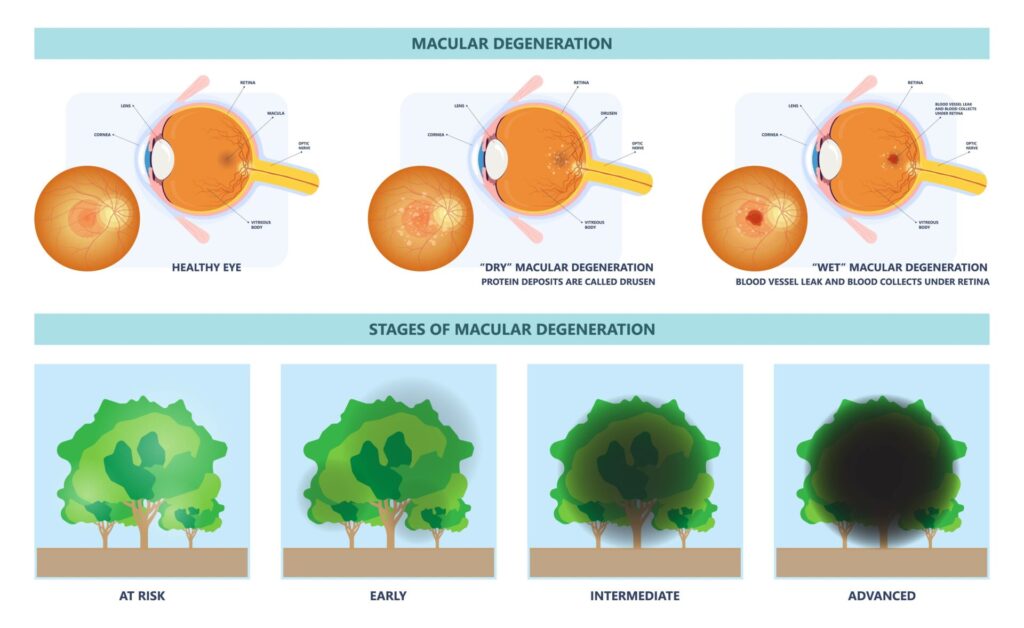Macular degeneration—also called maculopathy, age-related macular degeneration, or AMD—is a low-vision condition that affects your eyesight quality and can lead to permanent central vision impairment or partial vision loss. Older patients above 50 are more likely to develop AMD, and roughly 10% of the U.S. population is affected by this condition.
Older patients are more often affected by AMD because the condition involves the breaking down of the macula, or the tissues that receive light and convert them into nerve signals for the brain to process. Once layers of the macula begin degenerating, its ability to receive light and convert it correctly is interrupted. For many, this breakdown is just a natural part of the “wear and tear” a body goes through during aging.
Although macular generation most commonly affects older patients, young people with certain genetic complications risk developing juvenile macular degeneration in childhood or young adulthood. The most common forms of JMD are:
- Stargardt disease
- Best’s disease
- Juvenile retinoschisis
AMD is not a condition that will cause complete blindness since it does not affect your peripheral vision. Instead, it distorts your central vision, ruining your ability to see clearly, even with corrective lenses.

AMD can affect either one eye or both eyes. If you develop it in only one eye, you will likely not notice, especially if the other eye is strong and healthy enough to compensate for the central vision loss you are developing. In many cases, however, both eyes will develop AMD and cause central vision loss.
Wet vs. Dry Macular Degeneration
Patients with macular degeneration have one of two kinds: wet or dry. While both present fairly similar symptoms, there are distinct differences between each AMD type.
Dry Macular Degeneration
Dry macular degeneration occurs when only the macula breaks down. Most patients discover this breakdown in one eye first before they experience it in both eyes. The central vision loss can worsen over time, but many patients may report mild cases of dry AMD while others experience severe vision impairment.
Without routine eye exams from your ophthalmologist, you may not know you have dry macular degeneration until you start experiencing:
- Difficulty reading since the letters appear blurred or distorted
- Difficulty seeing in dimly lit rooms
- Difficulty seeing without the presence of brighter lights
- Distorted images where sharp, straight lines appear bent
- Impaired central vision where it looks as if a blurry spot is in the way of the object you are looking at
Risk Factors for Dry Macular Degeneration
Along with age, risk factors for dry AMD include:
- Having a family history of AMD or being genetically prone
- Being Caucasian
- Having a smoking habit
- Being obese
- Developing cardiovascular disease
What to Do if You Have Dry AMD?
Wet Macular Degeneration
Wet macular degeneration is a rarer form of AMD that always begins as dry macular degeneration with a breakdown of the macula. What sets wet AMD apart from the dry type are new-formed blood vessels that grow into the macula. If the blood vessels also break down, they can leak blood into the damaged macula, causing even more impairment and visual distortion.
Without routine eye exams from your ophthalmologist and without noticing any signs you have developed dry macular degeneration, you are likely to notice the same symptoms as dry AMD, but they will develop more suddenly and more severely than they do with the dry type.
Risk Factors for Wet Macular Degeneration
Along with age, risk factors for dry AMD include:
- Having a family history of AMD or being genetically prone
- Being Caucasian
- Having a smoking habit
- Being obese
- Developing cardiovascular disease
What to Do if You Have Wet AMD
If you notice signs of wet AMD, take the same steps as you would with dry AMD and visit your eye doctor as soon as possible. Your ophthalmologist can run diagnostic tests to confirm your condition and begin your treatment or management plan immediately.
If caught early enough, you may be able to slow the progression of AMD and save what is left of your central vision.
If you suspect you are suffering from macular degeneration or would like to complete a thorough eye exam to check, rely on Vision Eye Group.
Our ophthalmologists will check your eyes and determine whether macular degeneration is a concern for you. If we detect its progression, we will begin treatment or a management plan to help salvage your vision and maintain eye health. Schedule your appointment today: 478-744-1710
Recent Articles
